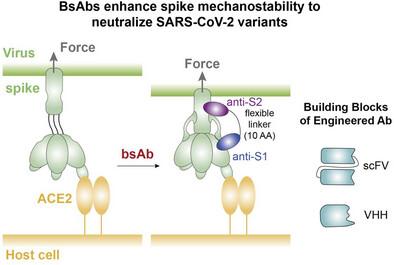广谱SARS - CoV - 2中和的机械锁定策略
IF 12.1
2区 材料科学
Q1 CHEMISTRY, MULTIDISCIPLINARY
引用次数: 0
摘要
病毒进入宿主细胞通常是由病毒表面蛋白和宿主细胞受体之间的相互作用发起的。传统的中和策略旨在破坏这些相互作用,但往往对快速变异的病毒株失去效力。这一挑战不仅限于SARS - CoV - 2,还包括艾滋病毒和流感等其他病毒。为了克服这一限制,提出了一种新的机械锁定策略,以SARS - CoV - 2为模型系统,其中双特异性抗体(bsAbs)通过阻止力诱导的构象变化将刺突蛋白锁定在其预融合构象中。在伪病毒检测中,这些bsab对多种SARS - CoV - 2变异具有广谱中和作用。单分子磁镊子实验进一步表明,这些bsAbs显著提高了S1-S2解离所需的机械力阈值,从而增强了刺突蛋白的机械稳定性。这种稳定机制提供了一种抗突变的中和方法,并为抗病毒治疗引入了一种新的设计范式。这些发现为开发生物力学增强策略建立了一个机械驱动的框架,该策略可能适用于广泛的机械激活包膜病毒。本文章由计算机程序翻译,如有差异,请以英文原文为准。

Mechano‐Locking Strategy for Broad‐Spectrum SARS‐CoV‐2 Neutralization
Viral entry into host cells is typically initiated by interactions between viral surface proteins and host cell receptors. Conventional neutralization strategies aim to disrupt these interactions but often lose effectiveness against rapidly mutating viral strains. This challenge extends beyond SARS‐CoV‐2 to other viruses such as HIV and influenza. To overcome this limitation, a novel mechano‐locking strategy is proposed, using SARS‐CoV‐2 as a model system, in which bispecific antibodies (bsAbs) lock the spike protein in its prefusion conformation by preventing force‐induced conformational changes. These bsAbs demonstrate broad‐spectrum neutralization efficacy against multiple SARS‐CoV‐2 variants in pseudoviral assays. Single‐molecule magnetic tweezers experiments further reveal that these bsAbs significantly raise the mechanical force threshold required for S1–S2 dissociation, thereby enhancing spike protein mechano‐stability. This stabilization mechanism offers a mutation‐resistant approach to neutralization and introduces a new design paradigm for antiviral therapeutics. These findings establish a mechanistically driven framework for developing biomechanically enhanced strategies potentially applicable to a wide range of mechanically activated enveloped viruses.
求助全文
通过发布文献求助,成功后即可免费获取论文全文。
去求助
来源期刊

Small
工程技术-材料科学:综合
CiteScore
17.70
自引率
3.80%
发文量
1830
审稿时长
2.1 months
期刊介绍:
Small serves as an exceptional platform for both experimental and theoretical studies in fundamental and applied interdisciplinary research at the nano- and microscale. The journal offers a compelling mix of peer-reviewed Research Articles, Reviews, Perspectives, and Comments.
With a remarkable 2022 Journal Impact Factor of 13.3 (Journal Citation Reports from Clarivate Analytics, 2023), Small remains among the top multidisciplinary journals, covering a wide range of topics at the interface of materials science, chemistry, physics, engineering, medicine, and biology.
Small's readership includes biochemists, biologists, biomedical scientists, chemists, engineers, information technologists, materials scientists, physicists, and theoreticians alike.
 求助内容:
求助内容: 应助结果提醒方式:
应助结果提醒方式:


